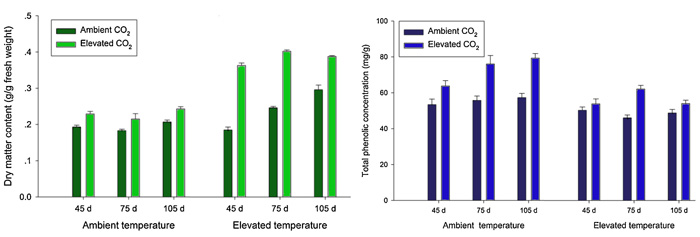| Follow @co2science |
Paper Reviewed
Zhang, S., Fu, W., Zhang, Z., Fan, Y. and Liu, T. 2017. Effects of elevated CO2 concentration and temperature on some physiological characteristics of cotton (Gossypium hirsutum L.) leaves. Environmental and Experimental Botany 133: 108-117.
Writing as background for their work, the five member research team of Zhang et al. (2017) note that cotton (Gossypium hirsutum) is "the most important oilseed and fiber crop worldwide, and plays a critical role in the global economy," where production presently amounts to around 25 million tones. Yet, despite interest in how this important species might respond to climate change, the researchers write that "the interactive effects of long term elevated [CO2] and temperature have rarely been examined," a deficiency they intended to remedy.
Working at Northwest A&F University in Yangling, Shaanxi, China, Zhang et al. grew cotton in climate-controlled growth chambers under two different temperature (27/20°C or 34/27°C day/night) and CO2 (400 or 800 ppm) regimes. The plants were then sampled and various parameters measured to observe the impact of elevated CO2 and elevated temperature on those parameters. And what did those measurements reveal?
As reported by the Chinese scientists, at the end of the experiment (105 days after sowing), elevated temperature enhanced dry matter by 43% under ambient CO2 conditions and by 60% under elevated CO2 conditions (see Figure 1, left panel). Dry matter was also enhanced by elevated CO2 (17% under ambient temperature conditions and 31% under elevated temperatures). The highest increase in dry matter content was noted in the elevated temperature and elevated CO2 treatment, suggesting to the authors that "[CO2] enrichment could enhance the effect of rising temperature on dry matter content."
Reporting on other parameters, Zhang et al. say that although early measurements made at 45 days after sowing revealed calculable differences, by 75 days after sowing and on through the end of their experiment they found no significant effect of elevated CO2 on leaf nitrogen or C:N ratio at either ambient or elevated temperature. Leaf soluble sugars, total starch and total foliar nonstructural carbohydrates, in contrast, all experienced marked increases from elevated CO2 under ambient and elevated temperatures. Additionally, they report that elevated CO2 tended to enhance total leaf phenolic concentrations whereas elevated temperature tended to reduce them (Figure 1, right panel). This latter finding is significant in that phenolic compounds, in the words of the authors, "play physiological and ecological roles including structural support, constitutive and induced protection and defense against herbivores, weeds and pathogens (Jones and Hartley, 1999)."

Figure 1. Impact of CO2 and temperature on the dry matter (left panel) and total phenolic concentration (right panel) of cotton plants, as determined by measurements made at 45, 75 and 105 days after sowing. Source: Zhang et al. (2017).
Reference
Jones, C.G. and Hartley, S.E. 1999. A protein competition model of phenolic allocation. Oikos 86: 27-44.




